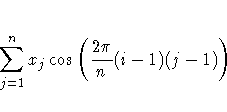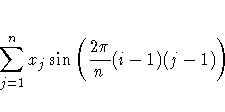Chapter Contents
Previous
Next
|
Chapter Contents |
Previous |
Next |
| Language Reference |


Note: For most efficient use of the FFT function, n should be a power of 2. If n is a power of 2, a fast Fourier transform is used (Singleton 1969); otherwise, a Chirp-Z algorithm is used (Monro and Branch 1976).
The FFT function can be used to compute the periodogram of a time series. In conjunction with the inverse finite Fourier transform routine IFFT, the FFT function can be used to efficiently compute convolutions of large vectors (Gentleman and Sande 1966; Nussbaumer 1982). An example of a valid statement follows:
a=fft(c);
|
Chapter Contents |
Previous |
Next |
Top |
Copyright © 1999 by SAS Institute Inc., Cary, NC, USA. All rights reserved.